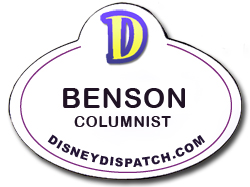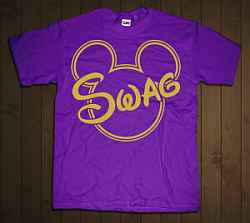FROM: It's All in a Nametag Published Thursdays
MAPO and Mary Poppins
Disney's MAPO division is well-known amongst hard-core fans, as is its full name: Manufacturing and Production Organization. But did you know that the real inspiration MAPO was... MAry POppins? Benson knows, and tells the tale.
If you're among the older generation, you might remember the recording artist Ray Conniff. He worked at Columbia Records, and was most famous for making extravagant arrangements of pop songs. In 1964, Ray and his group, The Singers, did an album of songs  from popular motion pictures of the day. Among those films was Mary Poppins.
from popular motion pictures of the day. Among those films was Mary Poppins.
To introduce his version of "A Spoonful of Sugar" as the first song on the record, Ray wrote a rather comical new first verse:
Oh Mary Poppins is her name, oh Mary Poppins is her name!
She flies through the air with her umbrella.
And if you get a chance to go, You ought to try to see the show.
You'll hear this song It's one you're sure to know..
Then the more familiar words to the song play.
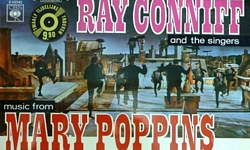
The cover of Ray Conniff's Mary Poppins record
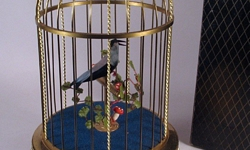
Walt Disney's mechanical bird
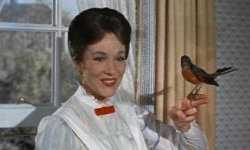
Julie Andrews as Mary Poppins, with the animatronic robin
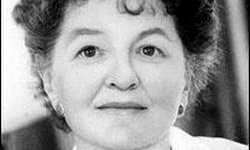
P. L. Travers
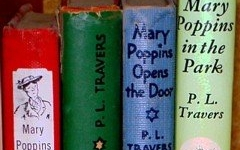
A few of the early Mary Poppins books
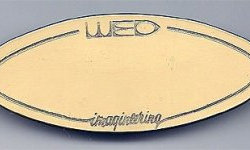
The nametag worn by employees at W.E.D. Enterprises in the early 1960's
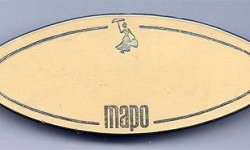
The nametag worn by employees at MAPO in the mid 1960's
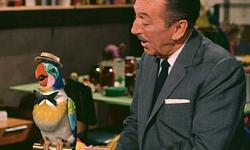
Walt Disney examines Jose, one of the animatronic birds created for the Enchanted Tiki Room
For any Disney fan, Mary Poppins is a rather familiar name. But how did she get the name? And how did she inspire the creation of all the Audio-Animatronic figures that inhabit Disney parks the world over?
How Does the Caged Bird Sing?
Really it first began in the early 1950's when Walt Disney took his family on a vacation to Europe. In the midst of their travels, they happened across a small antiques store. A mechanical bird in a cage  caught Walt's eye. It was an antique French automaton, an animated figure with complex inner workings that enabled it to move and sing a song.
caught Walt's eye. It was an antique French automaton, an animated figure with complex inner workings that enabled it to move and sing a song.
The mechanical bird, with its sophisticated internal engineering, long fascinated Walt. When he opened Disneyland in 1955, he knew that he wanted to create similar kinds of mechanical creatures to fill the park and entertain guests.
In 1962, the film version of Mary Poppins was deep in production at the Walt Disney Studios. Walt wanted to include an animated bird in the movie, along the lines of his treasured antique. So, at his request, Studio engineers created an animatronic robin that sang along with Mary Poppins.
But I suppose I should go a bit into where Mary Poppins  came from, in case you have never really known her back story.
came from, in case you have never really known her back story.
The Poppins of Print
Mary Poppins is the creation of an Australian-born author named Pamela Lyndon Travers  . First published in 1934, the book told the story of the Banks family, who lived on Cherry Tree Lane in an affluent part of London. Mary takes a job as a nanny to the Banks' four children. (It's interesting to note that only the older two children appear in the film adaptation.)
. First published in 1934, the book told the story of the Banks family, who lived on Cherry Tree Lane in an affluent part of London. Mary takes a job as a nanny to the Banks' four children. (It's interesting to note that only the older two children appear in the film adaptation.)
There is not one Mary Poppins book  , but rather eight in all: Mary Poppins Comes Back, Mary Poppins Opens the Door, Mary Poppins in the Park, Mary Poppins from A to Z, Mary Poppins in the Kitchen, Mary Poppins in Cherry Tree Lane, and Mary Poppins and the House Next Door. The last book was published in 1988, several years before Travers passed away.
, but rather eight in all: Mary Poppins Comes Back, Mary Poppins Opens the Door, Mary Poppins in the Park, Mary Poppins from A to Z, Mary Poppins in the Kitchen, Mary Poppins in Cherry Tree Lane, and Mary Poppins and the House Next Door. The last book was published in 1988, several years before Travers passed away.
When Walt Disney purchased the film rights for Mary Poppins, P.L. Travers was very insistent that she have a great amount of control over the production. She had final approval over the script, and wanted all the music to be authentic to the time period in which her book was set. She insisted that there be no romantic relationship between Bert and Mary Poppins. She also strongly objected to the Sherman Brothers songs in the film, as well as to the animated sequences. But Walt Disney refused to meet those latter two demands, insisting that they were essential to the atmosphere of the film.
But the real final straw for Travers was when she was not invited to the film's world premiere. She finally had to ask Walt Disney personally for permission to attend. That fact, and the way she disliked the way her book had been treated, caused Travers to never again allow her works to be adapted into a Disney film.
Poppins Equals Profits
Mary Poppins was a huge financial success for Walt Disney Productions. In its first theatrical release, it grossed more than $31,000,000, which is almost $220 million today, adjusted for inflation.
With the profits from the film, Walt Disney was able to greatly expand the division of the company that had created the animatronic robin for Mary Poppins. Initially, the group of engineers developing projects for Disneyland had been working at the Disney Studios as a special division called
W.E.D. Enterprises  . (It took its name from Walt Disney's initials, Walter Elias Disney.)
. (It took its name from Walt Disney's initials, Walter Elias Disney.)
In 1965, Walt Disney created a special division for the engineers who had worked on the animatronic robin. It was dubbed the
Manufacturing And Production Organization  , or MAPO for short (a portmanteau from the first two letters of the film, MAry POppins). The MAPO division created the animatronics for such popular park attractions as Pirates of the Caribbean,
Walt Disney's Enchanted Tiki Room
, or MAPO for short (a portmanteau from the first two letters of the film, MAry POppins). The MAPO division created the animatronics for such popular park attractions as Pirates of the Caribbean,
Walt Disney's Enchanted Tiki Room  , Great Moments with Mr. Lincoln, and many others.
, Great Moments with Mr. Lincoln, and many others.
More: IT'S ALL IN A NAMETAG
Stuff Not to Skip
- Benson Myers's Blog
http://mousebadges.blogspot.com/2010/12/disney-store.html - Benson Myers's Nametag Museum
http://www.nametagmuseum.com




